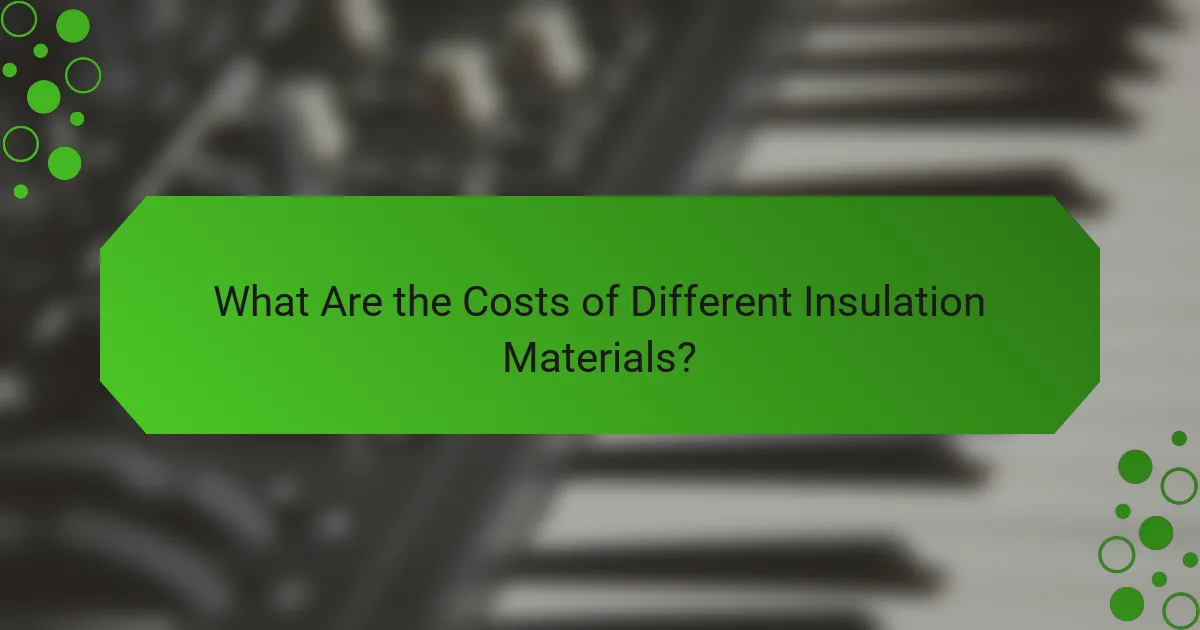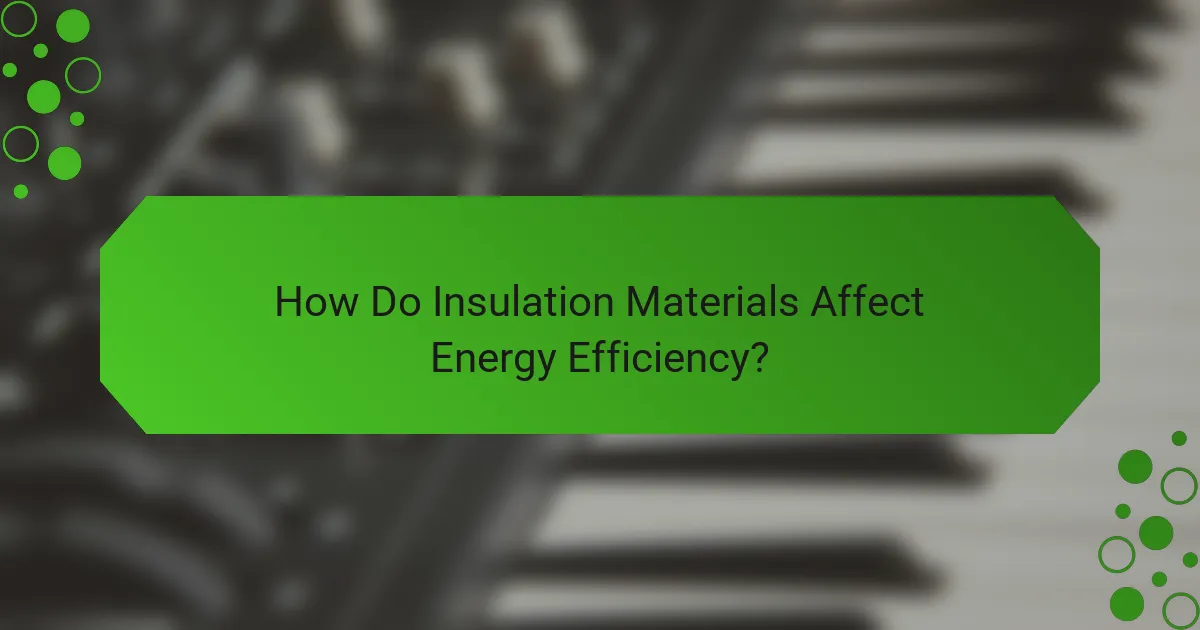Choosing the right insulation material is crucial for enhancing energy efficiency and comfort in homes. With options like fiberglass, foam board, cellulose, mineral wool, and spray foam, each material offers distinct properties and performance characteristics. Additionally, understanding the R-value, soundproofing abilities, and cost implications of these materials can guide homeowners in making informed decisions tailored to their specific needs.

What Are the Best Insulation Materials for Homes?
The best insulation materials for homes include fiberglass, foam board, cellulose, mineral wool, and spray foam. Each type has unique properties, costs, and performance characteristics that can significantly impact energy efficiency and comfort.
Fiberglass Insulation
Fiberglass insulation is one of the most common types used in residential buildings. It consists of fine glass fibers and is available in batts, rolls, or loose-fill forms. This material is known for its affordability and effectiveness in reducing heat transfer.
When considering fiberglass, look for products with a high R-value, which measures thermal resistance. Typical R-values range from R-11 for walls to R-38 for attics. Ensure proper installation to avoid gaps that can reduce performance.
Foam Board Insulation
Foam board insulation is rigid and provides excellent thermal resistance, making it ideal for foundation walls, basement walls, and exterior sheathing. It is lightweight and easy to handle, which simplifies installation.
This type of insulation typically has an R-value between R-4 and R-6 per inch of thickness. It is also moisture-resistant, which is beneficial in areas prone to dampness. However, it may be more expensive than fiberglass, so consider your budget and insulation needs.
Cellulose Insulation
Cellulose insulation is made from recycled paper products and is treated for fire resistance. It is often used as loose-fill insulation in attics and wall cavities, providing good coverage and reducing air leaks.
With an R-value of around R-3.5 to R-4 per inch, cellulose is a sustainable choice for eco-conscious homeowners. It can settle over time, so proper installation is crucial to maintain its effectiveness. Look for products that meet local building codes for fire safety.
Mineral Wool Insulation
Mineral wool, or rock wool, is made from natural or recycled materials and offers excellent soundproofing and fire resistance. It is available in batts or loose-fill forms and is suitable for various applications, including walls and attics.
This insulation type typically has an R-value of R-3.3 to R-4.2 per inch. It is resistant to moisture and mold, making it a good choice for humid climates. However, it can be more expensive than fiberglass, so weigh the benefits against your budget.
Spray Foam Insulation
Spray foam insulation expands on application, filling gaps and creating an airtight seal. It is available in open-cell and closed-cell varieties, with closed-cell offering higher R-values and moisture resistance.
Open-cell spray foam has an R-value of about R-3.5 to R-4 per inch, while closed-cell can reach R-6 to R-7 per inch. This type of insulation can be more costly upfront, but its energy efficiency and air sealing capabilities often lead to long-term savings on energy bills. Ensure professional installation for optimal performance.

How Do Insulation Materials Compare in Performance?
Insulation materials vary significantly in performance based on their R-value, soundproofing capabilities, and fire resistance ratings. Understanding these differences helps in selecting the right insulation for specific needs and building codes.
R-Value Comparison
The R-value measures an insulation material’s resistance to heat flow; the higher the R-value, the better the insulation. Common materials range from about R-3 for fiberglass batts to R-6 for spray foam, with some advanced options reaching R-7 or higher. When choosing insulation, consider the climate and local building codes, as higher R-values are often recommended for colder regions.
For example, in the northern United States, an R-value of 49 is often suggested for attics, while southern regions may require only R-30. Always check local regulations to ensure compliance.
Soundproofing Capabilities
Soundproofing effectiveness varies among insulation types, with some materials better suited for noise reduction. Dense materials like mineral wool and cellulose provide superior sound absorption compared to fiberglass, which is less effective in blocking sound transmission.
For optimal soundproofing, consider using a combination of insulation and sound barriers, especially in multi-family dwellings or home theaters. Look for products specifically labeled for soundproofing to ensure they meet your needs.
Fire Resistance Ratings
Fire resistance ratings indicate how well insulation materials can withstand heat and flames. Materials like mineral wool and fiberglass are non-combustible and can withstand high temperatures, while foam insulations may require fire-retardant additives to meet safety standards.
Building codes often dictate the required fire resistance for insulation in specific areas, such as near heating systems or in attics. Always verify that your chosen insulation complies with local fire safety regulations to ensure safety and insurance coverage.

What Are the Costs of Different Insulation Materials?
The costs of insulation materials vary significantly based on type, performance, and installation requirements. Understanding these costs can help you make informed decisions for your insulation projects.
Fiberglass Cost per Square Foot
Fiberglass insulation typically ranges from about $0.50 to $2.00 per square foot, depending on the type and thickness. It is widely used due to its affordability and effectiveness in thermal resistance.
When considering fiberglass, be aware of installation costs, which can add $0.50 to $1.00 per square foot if you hire professionals. DIY installation can save money, but ensure you follow safety guidelines to avoid inhaling fibers.
Foam Board Cost per Square Foot
Foam board insulation generally costs between $1.00 and $3.00 per square foot. It offers excellent thermal performance and is often used in foundation walls and exterior applications.
Keep in mind that while foam board can be more expensive upfront, its superior insulation properties can lead to energy savings over time. Installation costs may vary, so consider whether to install it yourself or hire a contractor.
Cellulose Cost per Square Foot
Cellulose insulation costs around $0.60 to $2.00 per square foot, making it a competitive option. It is made from recycled paper products and is treated for fire resistance, making it an eco-friendly choice.
Installation can be done through blowing or dense packing, which may require professional help, adding to the overall cost. However, cellulose’s excellent air sealing properties can enhance energy efficiency, potentially offsetting initial expenses over time.

What Factors Should You Consider When Choosing Insulation?
When selecting insulation, consider factors such as climate, installation method, and environmental impact. These elements will influence the effectiveness, cost, and sustainability of your insulation choice.
Climate Considerations
Your local climate significantly impacts the type of insulation you should choose. For colder regions, materials with high R-values, such as spray foam or fiberglass, are ideal for retaining heat. In warmer climates, reflective insulation or radiant barriers can help keep homes cool.
Additionally, consider humidity levels. In areas with high moisture, materials resistant to mold and mildew, like closed-cell spray foam, are preferable. Always check local building codes for insulation requirements specific to your climate zone.
Installation Method
The installation method can affect both the performance and cost of insulation. Some materials, like batts and rolls, are easier for DIY installation, while others, such as spray foam, typically require professional installation due to their complexity and equipment needs.
Consider the labor costs associated with professional installation, which can vary widely. For example, spray foam may cost more upfront but can provide better long-term energy savings, making it a worthwhile investment.
Environmental Impact
When choosing insulation, assess its environmental impact, including production processes and recyclability. Materials like cellulose, made from recycled paper, are eco-friendly options, while traditional fiberglass has a higher carbon footprint.
Look for insulation products with certifications such as Energy Star or those that meet local green building standards. These certifications can help ensure that your insulation choice is not only effective but also sustainable.

How Do Insulation Materials Affect Energy Efficiency?
Insulation materials significantly influence energy efficiency by reducing heat transfer, which lowers heating and cooling costs. Effective insulation helps maintain a stable indoor temperature, ultimately leading to energy savings and improved comfort.
Energy Savings Potential
The energy savings potential of insulation materials varies based on their type, thickness, and installation quality. For example, materials like spray foam and rigid foam boards typically offer higher R-values, meaning they provide better thermal resistance compared to fiberglass or cellulose.
Homeowners can expect energy savings ranging from 10% to 30% on heating and cooling bills when using high-performance insulation. Choosing the right insulation for your climate zone is crucial; colder regions may benefit more from thicker insulation, while milder areas may require less.
To maximize energy savings, ensure proper installation and consider air sealing to complement insulation. Common pitfalls include gaps or compressions in insulation, which can significantly reduce its effectiveness. Regular inspections can help maintain optimal performance over time.
